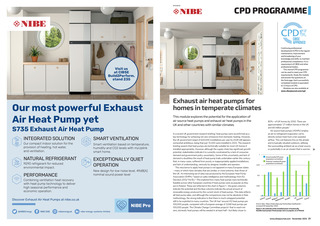


SPONSOR CPD PROGRAMME Continuing professional development (CPD) is the regular maintenance, improvement and broadening of your knowledge and skills, to maintain professional competence. It is a requirement of CIBSE and other professional bodies. This Journal CPD programme can be used to meet your CPD requirements. Study the module and answer the questions on the final page. Each successfully completed module is equivalent to 1.5 hours of CPD. Modules are also available at www.cibsejournal.com/cpd Exhaust air heat pumps for homes in temperate climates This module explores the potential for the application of air source heat pumps and exhaust air heat pumps in the UK and other countries with similar climates In a recent UK government research briefing,1 heat pumps were reconfirmed as a key technology for achieving net zero emissions from domestic heating. However, the UK government target of 600,000 installations per year by 2028 still appears somewhat ambitious, being that just 72,000 were installed in 2022. The research briefing asserts that heat pumps are technically suitable for most UK homes if installed appropriately. However, although the supply chain has significant growth potential, stakeholders indicate it is currently constrained by a lack of consumer demand and government policy uncertainty. Some of this uncertainty and lack of demand is doubtless the result of heat pump trials undertaken earlier this century that, in many cases, suffered from poorly or inappropriately applied installations and lack of understanding, variously by designer, installer and operator. This reluctance to apply heat pumps is not apparent in many European states many of which have climates that are similar, or more extreme, than those of the UK. An interesting set of data was produced by the European Heat Pump Association (EHPA),2 based on sales intelligence and methodology from EU Decision 2013/114/EU.3 This explored how many heat pumps were technically feasible across other European countries if heat pumps were as popular as they are in Finland. These are reflected in the chart in Figure 1 the green columns indicate the potential and the blue columns indicate the actual amount of renewable energy produced by the current stock of heat pumps. This data reflects all heat pump sales, and although the comparisons may not be absolute in their methodology, the strong indication is that there is much untapped potential still to be exploited in many countries. The UK has4 around 412 heat pumps per 100,000 people, compared with a European average of 3,068 heat pumps per 100,000 people. The Climate Change Committee projects5 that to reach net zero, domestic heat pumps will be needed in at least half but likely closer to 80% of UK homes by 2050. There are approximately6 27 million homes in the UK and 68 million people.7 Air source heat pumps (ASHPs) employ an air-to-refrigerant evaporator coil to directly extract heat from a fan-assisted airflow. This coil features fins on the airside and is typically situated outdoors, utilising the surrounding ambient air as a heat source, or potentially in an air stream that is warmer 1 Actual installed HP power (population normalised) Potential installed HP power 0.75 (population normalised) 0.5 0.25 nd nland nds weden ium Irela Fi S Belg etherla N UK rmany France Ge Source data : https://stats.ehpa.org/home/ehpa-dashboard/ accessed 30 September 2023. Figure 1: An estimate of the installed power of technically feasible heat pumps if heat pumps were as popular as in Finland www.cibsejournal.com November 2023 21 CIBSE CPD Nov 23.indb 21 02/11/2023 16:51